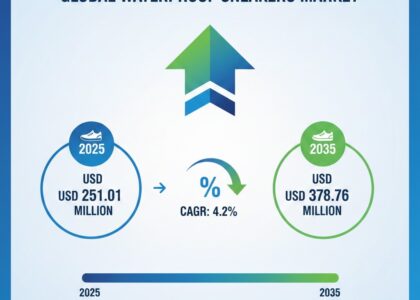
The global e-learning solution market is projected to witness remarkable growth, expanding from USD 420.3 million in 2025 to approximately USD 3,782.1 million by 2035. This impressive expansion reflects a compound annual growth rate (CAGR) of 16.4% during the forecast period. The market’s upward trajectory is being driven by the increasing demand for digital learning environments across various sectors, including BFSI, healthcare, IT, education, manufacturing, and government. Organizations are increasingly adopting vendor-specific and partner-oriented e-learning platforms to ensure consistency in training, performance tracking, and upskilling across distributed teams and external collaborators. As businesses navigate rapid digital transformation, e-learning solutions are becoming central to enabling scalable and personalized learning experiences that align with organizational goals.
The growing complexity of workforce structures, the need for compliance training, and the emphasis on continuous learning are prompting enterprises to shift toward integrated, cloud-based learning management systems (LMS) and content delivery platforms. Whether used to onboard employees, educate customers, or certify third-party partners, modern e-learning solutions provide intuitive interfaces, rich analytics, mobile compatibility, and real-time feedback. Furthermore, the push toward hybrid work models, decentralized offices, and remote operations has underscored the value of flexible, always-on training systems. The e-learning ecosystem is evolving from static courseware into dynamic, collaborative platforms that foster innovation, inclusion, and adaptability across global organizations.
Request Your Sample and Stay Ahead with Our Insightful Report!
https://www.futuremarketinsights.com/reports/sample/rep-gb-11787
Key Takeaways from the E-Learning Solution Market
One of the most notable takeaways from the e-learning solution market is the accelerating adoption of tailored learning modules designed for specific industries and roles. Businesses in banking and financial services are leveraging e-learning platforms for compliance training, fraud prevention, and customer service modules. In healthcare, institutions use digital training solutions for clinical education, regulatory training, and patient safety awareness. The IT and tech sectors are integrating certifications and code labs directly into learning platforms to streamline technical onboarding and continuous development. These industry-specific approaches ensure higher engagement, faster knowledge transfer, and measurable performance outcomes, making e-learning a strategic tool rather than a mere utility.
Another important insight is the shift from traditional LMS tools to immersive, experience-driven learning environments. Organizations are investing in platforms that incorporate multimedia content, social collaboration, gamification, and personalized pathways. These capabilities are enhancing learner motivation, knowledge retention, and application in real-world scenarios. Moreover, e-learning is increasingly being utilized beyond internal training—extending to channel partners, vendors, franchisees, and even end users—creating new revenue streams and expanding the scope of digital education.
Emerging Trends in the Global E-Learning Solution Market
The e-learning solution market is being shaped by several transformative trends. A key development is the integration of artificial intelligence and machine learning to deliver adaptive learning experiences. AI-driven platforms can now personalize content based on a learner’s role, behavior, knowledge gaps, and progress, offering real-time suggestions and intelligent assessments. This results in a more efficient, impactful, and data-backed learning journey.
Another prominent trend is the rise of microlearning and mobile learning formats. With attention spans shrinking and schedules becoming more fragmented, learners are increasingly favoring short, focused content that can be consumed on the go. Mobile-first platforms are enabling bite-sized modules, interactive videos, quizzes, and push notifications to maintain engagement and learning continuity. Gamification elements—such as leaderboards, rewards, and progress tracking—are also gaining popularity, especially in high-turnover industries like retail, hospitality, and logistics.
Virtual reality (VR) and augmented reality (AR) technologies are beginning to gain traction in the e-learning space, particularly in industries requiring experiential or safety-critical training. From virtual factory tours and equipment handling simulations to medical procedures and emergency response drills, immersive e-learning solutions are enabling hands-on learning without physical constraints. Additionally, the growing popularity of multilingual and accessible content ensures that e-learning platforms cater to diverse, global, and inclusive workforces.
Significant Developments and Opportunities in the Sector
Opportunities in the e-learning solution market are expanding as businesses reimagine employee development as a continuous, strategic function. With digital transformation becoming a boardroom imperative, learning and development (L&D) functions are being restructured to align with business outcomes, talent retention, and innovation goals. E-learning platforms are now being integrated with enterprise systems like CRM, ERP, and HCM platforms to enable seamless knowledge sharing, performance analysis, and workflow automation.
There is also significant momentum in government and education sectors, where digital learning is being used to bridge infrastructure gaps, deliver equitable education, and reskill populations for the digital economy. Public-private partnerships and national digital literacy campaigns are creating new demand for scalable, secure, and cost-effective learning solutions. Meanwhile, academic institutions are collaborating with e-learning providers to offer online degree programs, certifications, and MOOCs that extend their reach and relevance.
In the corporate sector, e-learning is emerging as a critical enabler for change management, organizational agility, and cultural transformation. As industries face rapid technological shifts and regulatory changes, the ability to train and realign workforces quickly through digital platforms is proving essential for resilience and competitiveness.
Recent Developments in the Market
Recent years have seen an explosion in platform innovation and market activity. Major providers have introduced AI-powered learning assistants, advanced analytics dashboards, and no-code content authoring tools to streamline the creation and delivery of training content. In 2024, a leading cloud software firm partnered with an e-learning provider to launch an enterprise learning marketplace that integrates with internal HR systems and offers curated learning paths from multiple content creators.
Edtech startups and scale-ups have secured funding rounds to enhance their platform capabilities, expand their content libraries, and accelerate go-to-market strategies. The pandemic-driven e-learning boom has evolved into a mature, sustained demand for digital training tools across all organization types. Content interoperability and SCORM/xAPI compliance have become standard features, ensuring compatibility across LMS and authoring tools. Collaborative learning tools, such as discussion boards, virtual classrooms, and peer feedback systems, are being integrated to replicate in-person interactions digitally.
Thorough Market Evaluation: Full Report
https://www.futuremarketinsights.com/reports/e-learning-solutions-market
Competition Outlook in the E-Learning Solution Market
The competitive landscape of the e-learning solution market features a mix of global technology companies, specialist LMS providers, edtech innovators, and content-focused platforms. Key players include SAP Litmos, Cornerstone OnDemand, Docebo, Blackboard, Adobe Captivate Prime, TalentLMS, Udemy Business, Skillsoft, Coursera for Business, and Moodle. These firms are competing on usability, scalability, integrations, analytics, and content ecosystem depth. Many vendors are forming strategic alliances with content creators, academic institutions, and enterprise IT providers to deliver holistic learning solutions.
Key Segmentations
Market segmentation is generally based on component (platforms, content, services), deployment type (cloud-based, on-premises), end-user (corporate, academic, government), and application (technical training, compliance, soft skills, certification programs). Regionally, North America leads due to its early digital learning adoption and tech ecosystem, while Asia Pacific is witnessing rapid growth due to large-scale digital skilling programs and increasing mobile learning penetration.
About Future Market Insights (FMI)
Future Market Insights, Inc. (ESOMAR certified, recipient of the Stevie Award, and a member of the Greater New York Chamber of Commerce) offers profound insights into the driving factors that are boosting demand in the market. FMI stands as the leading global provider of market intelligence, advisory services, consulting, and events for the Packaging, Food and Beverage, Consumer Technology, Healthcare, Industrial, and Chemicals markets. With a vast team of 400 analysts worldwide, FMI provides global, regional, and local expertise on diverse domains and industry trends across more than 110 countries.
Contact Us:
Future Market Insights Inc.
Christiana Corporate, 200 Continental Drive,
Suite 401, Newark, Delaware – 19713, USA
T: +1-845-579-5705
For Sales Enquiries: sales@futuremarketinsights.com
Website: https://www.futuremarketinsights.com
LinkedIn| Twitter| Blogs | YouTube





